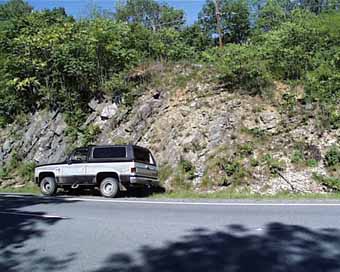
 This nice little fold in the Tonoloway identifies this outcrop we saw. As you quickly observed when we arrived, this is a carbonate tidal system, similar in some respects to the Conococheague we saw earlier in the day (Stop 1), but also very different.
This nice little fold in the Tonoloway identifies this outcrop we saw. As you quickly observed when we arrived, this is a carbonate tidal system, similar in some respects to the Conococheague we saw earlier in the day (Stop 1), but also very different.
The tidal features include algal laminated micrites (right), ribbon rock (below), mud cracks (prism cracks), and a lot of bioclastic sands most likely deposited in a tidal channel. There are also ostracods found in places in this outcrop.
What is different from the Conococheague is the diminutive scale of the structures. Everything seems to be in miniture.
|
 The miniature nature of things were best seen on the opposite side of the road where we saw a cycle from ribbon rock (subtidal), to cross laminated carbonate fine sand (intertidal), to algal laminated ribbon rock (upper inter to super tidal). The cross laminated sands, in particular, were diminutive, with tiny cross laminations mm high, and tiny scour channels sometimes less than a cm deep and only a few cm long.
The miniature nature of things were best seen on the opposite side of the road where we saw a cycle from ribbon rock (subtidal), to cross laminated carbonate fine sand (intertidal), to algal laminated ribbon rock (upper inter to super tidal). The cross laminated sands, in particular, were diminutive, with tiny cross laminations mm high, and tiny scour channels sometimes less than a cm deep and only a few cm long.
|
|

